|
there is much to see
mud railroad mud sculptures mud
but not in the dark
|
After an unexpectedly awesome way to spend the middle part of the day, we were beginning to push our luck with the amount of time that it might take to get from Marree to Coober Pedy. In addition, we still had no idea what condition the road would be in by this time, though we were hoping it would have dried out significantly.
We pulled back up to the floodway just north of town to find that, in fact, no... The water was still pretty wet, though it had gone down somewhat.
We sat debating for a while, taking pictures, and generally not being passed by anyone, since no one else was going to be out crossing the creeks.
We reasoned that the water had indeed receded a bit since last we were sitting here because the handy gauge, which you can see over here to the right, records the depth at a paltry 0.2 meters, which would hardly wet the belly of a dingo.
"Wet the belly of a dingo?" What kind of strange new Australianism is that? It isn't really. We have no idea whence that came... You have our sincere apologies.
For those of you biting your nails waiting to find out, 0.2 meters is 0.656167979 feet. Feel better?
The water had already set us off on a late start, so we were not going to be held up any longer. Particularly since we had such a tall dingo.
Ok, sorry; that was uncalled for. Our dingo apologizes. Bad dingo.
Anyway, we made it through the 0.656167979 feet of water without incident and significantly emboldened by the success. We were now free to drive like mad into the outback.
As predicted, that first floodway outside of Marree would not be the only wet spot. We found several. All at breakneck pace. Did we mention we were running late to make it to Coober Pedy?
At the next big mud hole, Lea Ann broke out the camera to document our progress:
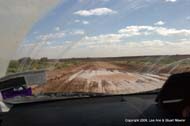
|

|
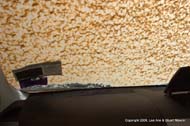
|
Uh oh...
|
Ramming speed...
|
Where did the road go?
|
Fortunately, there are wipers on the windscreen, but the passenger side window started looking a bit ugly...
As you can see in the larger version, even rolling down the window did nothing to scrape the outback off the window. To see anything, Lea Ann had to roll down the window.
And there were more mud holes to come!
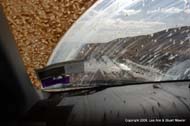
|
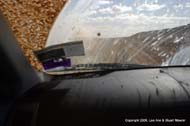
|
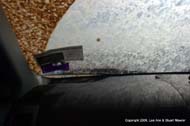
|
Here we go again...
|
Mid-splash...
|
Hey, that one was mostly water!
|
Another interesting tidbit of note: In the first picture of the first series, the side of the road is visible. Look at how green everything is! In just one night of heavy rain, the desert turned into a lush garden.
In a few kilometers, all the water and the newly lush vegetation was gone again. Desert rains are very localized.
The road turned into a dusty track extending many kilometers into the distance (way beyond the curve of the Earth).
For a sense of perspective, the airplane trip earlier in the day allowed us to take pictures well to the northwest of the photograph to the right.
As a side benefit, we now were adding layers of dust to our muddy SUV.
A few kilometers along, we drove right by some features we had seen from the airplane.
These few bumps in the picture to the right are actually salt domes. (We have one awesome picture of these under dappled light, as seen from the airplane.)
The important thing about salt domes out here is that they indicate the presence of water. The early explorers originally navigated between these domes. Early farm stations relied on them to water their livestock. According to something we read, the domes have been neglected recently, with the advent of deep well drilling. As a result, livestock often foul the tiny springs.
At this same location, we paused to look behind us...
This is the landscape that many of our new Australian friends had found to be incredibly boring. Perhaps it is, but the vastness is amazing. The subtle colors are fascinating.
We clearly did not find this very boring.
From time-to-time, we would still come across standing water.
Usually, the water was, like the picture to the right, accompanied by an Old Ghan Railway trestle.
The contrast between the floodway with standing water and the pictures up and down the roadway is astounding. Clearly, this is dry country.
We eventually paused to get a look at the truck from the outside (primarily because we were having trouble seeing from the inside).
We had to make sure to get our best side...
In all actuality, the far right picture was taken at a different stop than the first two. In the last picture, we were stopped at the Oodnadatta Sculpture Garden, where we took this picture:
Pretty amazing sculpture, eh?
Ok, you caught us, that is not a sculpture. What can we say? We like tiny flowers!
Ever so many years ago, on our honeymoon, we visited an "attraction" in Alberta called The Crystal Village. For those who like roadside peculiarness, The Crystal Village was a gold mine: an entire miniature town, where all the buildings are made of glass insulators. No kidding. Many of the town buildings were also populated by Barbie and Ken dolls.
However, what really made The Crystal Village weird was the setting. It was adjacent to a farmstead on the high plains, so there were no trees of any kind for miles. Most notably, though, there we no people to be seen anywhere. We spent an hour or so, but never saw anyone. Instead, we were greeted by a very large, friendly dog masquerading as a polar bear.
With the Oodnadatta Sculpture Garden, the feeling was somewhat similar: odd items scattered over the desert as though from some strange civilization.
When you come in at the south end, you start with "Plane Henge".
Plane Henge is clearly a notable icon on the landscape, but there are many other sculptures of varying size scattered over a large expanse of land.
The little guy to the right was just north of Plane Henge. It is, frankly, hard to tell just what this thing is or what it is doing, but it seemed like it deserved a photo.
Surprisingly, it held this pose the entire time.
Since most of the sculptures are made of old rusted bits of industrial detritus, it lends itself to black and white.
Of course, we had to keep changing from the color CF card to the black and white CF card...
The next few come in pairs to show the original color picture and the black and white that derived from it.
|
|
color...
|
|
black & white...
|
|
|
|
color...
|
|
black & white...
With a bit of a cheat, since there is a blue "hot spot" just under the pendulum. We managed to get the clouds arranged just right.
|
|
|
|
color...
|
|
black & white...
|
|
|
|
color...
|
|
black & white...
The contrast of the dark blue sky and the very white clouds just lent itself to black & white.
|
|
|
|
color...
You can see Plane Henge in the left background.
|
|
black & white...
|
|
This next creature is waving to passers by on the road, while holding an infant sculpture.
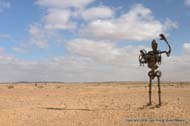
|
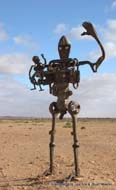
|
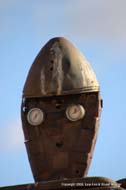
|
There might be a career available for this thing at Wal-Mart...
"Hi, welcome to the Oodnadatta Sculpture Garden, be sure to look for specials on rusted flotsam & jetsam!"
|
Does that arm ever get tired?
|
If you look into the eyes, you can "gauge" what it is thinking...
|
We are not entirely clear if the next critter is holding the other sculptures hostage with a strange ray-gun, or if it frozen in the midst of making some alien home movie of its own trip to the garden.
|
|
color...
There is a giant flower in the background, made of an old-style windmill.
|
|
black & white...
There are different filters applied to this one for a more "harsh" effect than the black & white images above.
|
|
|
|
This one is not actually black & white, but is backlit.
|
|
Plane Henge (in the far right background) appears to be the object of this critter's attention.
Is it possible that these things are aligned somehow with the solstices and/or equinoxen? Seems like a lot of work... (We would make crappy druids.)
|
|
Here are another couple of random images...
|
|
This is the giant flower that appeared in the background of a photo above. Note that the flower to left of center appears to be an "fully-grown" sculpture, with a "juvenile" to the right side of the frame.
What do you suppose they feed these things to make them grow up so large?
|
|
Can anyone tell whether or not this is a sculpture or just a pile of yet-to-be-used junk?
We felt a little like the people gathered around the fire extinguisher in the modern art gallery, commenting on the strength of the composition...
|
|
The sculpture garden is placed right on the right of way for the Old Ghan Railway. As a result, the sculptors worked in a few railway elements with their characteristic whimsical touches.
This is one of our favorites: The Ghan Hover-Bus Service.
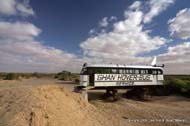
|
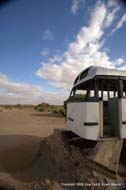
|
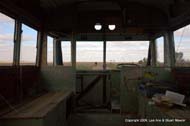
|
The Hover-Bus is sitting on what remains of an old railway bridge.
|
This picture gives a good sense of how the water wreaks havoc on the rail bridges.
|
You are encouraged to visit the inside of the Hover-Bus. On the right side, you can see the Hover-Bus Library. Feel free to deposit a book or borrow one. Sadly, we did not have a book to contribute.
(Out the front window, you can see Lea Ann approaching the bus along the Old Ghan tracks. She had better move before she gets run over...)
|
However, probably the most famous sculpture is a bit farther north:
This piece is actually an old water tower, made to look like a dog. We took a grainy picture of this same thing earlier in the day from the plane:
Since the dog was a hike north, we were covered in biting flies, and very hot, we decided to turn back toward the truck. (Yes, we spent most of the time perfecting our "Outback Salute"... a constant swatting with both hands. Kinda hard to take a picture with this happening.)
On the trip back toward the truck, we walked by some pieces we had not seen earlier. It was very fortunate, since we were able to locate the next contributor to Stuart's band Cliff Art:
|
|
If possible, it looks like this instrument might be even more difficult to move than Cliff's Alembic 8-string.
|
|
By the looks of the fellow, he should fit right in with the group.
|
|
We finally decided to head out, while there was still some light left, but did not get far. In the homestead compound just beyond the sculpture garden was a piece that accurately reflects the realities of work and commuting to work in modern society.
We definitely see this as a very large hampster wheel. Who has not thought of their trip to work like running on a wheel?
After finally wrestling ourselves away from the sculpture garden, we made the decision to simply drive by some attractions from the Old Ghan Railway. Oh well, maybe next time.
However, we could not resist the South Lake Eyre overlook.
|
|
Definitely getting dark and overcast again.
(The lake is in the far right distance in this picture.)
|
|
The sky was promising a dramatic sunset.
(The lake is less visible in this shot, but still to the far right distance.)
|
|
Now that the sun had pretty much left the sky, we could just drive on make it to our destination.
Oh yeah, there is the "problem" of sunset. We would be needing to stop twice to get different views of it. A desert sunset is a beautiful thing, but we will only subject you to a few pictures.
As we drove along, we were compelled to stop at a "high spot" because it was just too striking.
Note that none of the above pictures are black and white. The picture on the lower right was taken looking just slightly north, so the colors are more muted.
Having finally wrestled ourselves free from the sunset, it went ahead and became even more striking, so we had to stop again... Without complete darkness, we might never get anywhere.
If you have made it this far, you probably noted the mud-caked condition of the truck. Some of the windows were almost completely opaque, covered, as they were, with a thick coating of red dirt.
While Lea Ann photographed the sunset, Stuart had some time to consider the situation. If the mud has made the windows completely opaque, what about the headlights? Hmm, could be a problem.
So, we determined yet another good reason to bring water on a trip to the Outback: it provides an efficient way of making sure your headlights actually illuminate the road ahead. The picture to the right is Stuart actually cleaning the headlamps with a box of water.
And with that, it was finally dark enough to get moving.
To be fair, we did stop to take a picture of a road sign, and briefly considered staying at William Creek (at the intersection of William Creek Road and the Oodnadatta Track), but mostly we just drove until we reached Coober Pedy.
Avian Interlude
Why did the Corella cross the road?
To get to the sculpture garden, of course.
|

